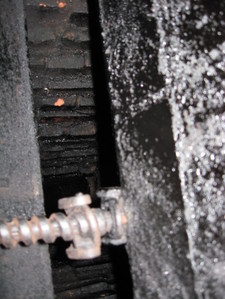
by blogediter | Apr 5, 2019 | Chimney Plugs
Q: Jason, On the “Sizing a Chimney Balloon” portion of the Chimney Balloon fireplace damper website it says to find a spot in the chimney that is low, like in the smoke shelf of the smoke chamber or by the damper, to measure for and install your Chimney Balloon? Why shouldn’t I just measure higher-up in the flue and install a Chimney Balloon up there? A smaller Chimney Balloon costs less money. – JC
A: JC, I know it is tempting for you to think we recommend a lower install location because we are just trying to sell a larger more expensive Chimney Balloon. But that is not why we suggest this. There are a number of reasons why you should install a Chimney Balloon in a lower location. Here are a few:
- It is best to install a Chimney Balloon in an area that you can reach with your hand because it will be easier to install and uninstall. When installing the Chimney Balloon you may need to prod a corner into place or adjust the alignment of the Chimney Balloon with your hand, and this is easier to do if the Chimney Balloon is installed in an easy to reach location. We make handle valve extenders for the Chimney Balloon in case it is not possible to install in an easy to reach location.
- If you do have a smoke shelf or smoke chamber then this structure shelf will help to support the weight of the Chimney Balloon once installed. The Chimney Balloon is designed to hold itself in place just by grabbing the flue sides through air pressure, but a smoke shelf makes its job even easier as it gives the bottom of the Chimney Balloon a location to rest. If the shelf is unusually deep and you need the valve of your Chimney Balloon to be somewhere other than the direct center of the Chimney Balloon this can be done through our custom order process. Here is a link to the blog about how to order a custom Chimney Balloon.
- If you install a Chimney Balloon low down you will be sealing off more of the fireplace inner chimney surface from your home. There are two advantages to this. If the creosote of your fireplace is particularly smelly or humid this isolates your home air from being contaminated by the chimneys smoky creosote smell. The other advantage is that heated air in a fireplace chimney tends to naturally cool and sink and create a draft sensation (Here is an article that addresses problems with top sealing dampers that tend to not stop the chimney draft)
The damper photo image above is a perfect example. The fireplace owner told us the chimney area is humid and sooty and smelly and the damper leaked cold air. We recommended a Chimney Balloon to be installed just above the damper, nice and low. After the customer installed the properly sized Chimney Balloon and used vinegar to neutralize the smokey aroma, the stinky fireplace smell stopped for good. – Jason
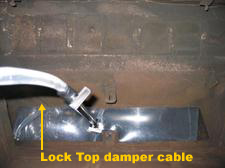
by blogediter | Apr 3, 2019 | Chimney Plugs
Q: I have a top sealing damper, and I still get a draft from my fireplace. It cost me $550 to get the chimney top damper put on my chimney and it only half solved the problem. Will a $50 Chimney Balloon stop the draft that is still there? – DP
A: DP – I remember talking to a Chimney Balloon customer from Detroit on the phone for nearly one hour regarding this very same issue. The result of our conversation was that the lock top damper and Chimney Balloon damperwork well together. The Locktop (otherwise known as a top sealing damper) and Lymance dampers keep birds and animals out and the Chimney Balloon stops the convection draft and chimney odor. You can use one or the other alone, but using them together is a very effective approach at eliminating draft, odor and other infiltration. This is an issue that we have addressed before in the Chimney Balloon Blog, but it is worth revisiting since it is a common question.
The light draft you are experiencing with the lock top or lymance damper is very common with top sealing dampers. When you seal a chimney at the top you are making your chimney into a large stopped tube that still has to be filled with warm interior air, so your furnace heats that air and it rises up into the chimney. Over time this air cools against the cold metal of the top damper and starts to sink. When it sinks it creates a light cool draft sensation in the hearth or the opening of the fireplace. This makes it feel like the damper is letting in cool air.
If you install a Chimney Balloon low in your fireplace you will eliminate this cold draft sensation. You may have concerns about the lock top or lymance damper chain or cable interfering with the Chimney Balloon, but we have found most of the time the Chimney Balloon will form around this chain or cable without a problem. However, there are a few things to keep in mind about the chain or cable for a lock top damper.
In the picture above the top sealing damper cable as a very faint line just to the left of the Chimney Balloon valve in the picture (see the orange arrow). You can also see that the Chimney Balloon has folded around and enveloped the cable. You see the cable runs along the edge of the metal damper there as well. In this application, the cable is getting frayed over time as it rubs up and down against the metal edge of this damper opening. That frayed section of cable has little needle-like protrusions and a flat side that is like a saw blade in roughness. Also, notice that the Chimney Balloon is tight like a drum. It is probably a little two tightly inflated.
- In this type of application wrap packaging tape around your chimney top damper cable in the area, the Chimney Balloon will come in contact with it. This will keep the flat sharp end of this cable from cutting the balloon. Also, do not actuate the cable by opening and closing the damper while the Chimney Balloon is in place. Remove the Chimney Balloon before you move the cable.
- When the Chimney Balloon is installed do not fill it drum tight full with air. Leave a little springiness in it.
- Also, purchase a Chimney Balloon that is a little oversized to allow for the extra material to envelop the cable. Two or three inches extra in length and width should give you what you need. In this photo example, a 33×12 could have been used normally, but they bought a 36×15 to get it around the damper cable.
If you take these prescribed precautions your Chimney Balloon will work just fine with your top sealing damper and stop the cold draft. – Jason
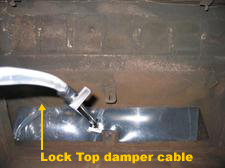
by blogediter | Nov 30, 2018 | Chimney Plugs
Lock top damper cable
Q: Jason – I currently have a chimney cap installed with a stainless steel wire and handle on the end which is mounted to the side of the firebox on the face of the brick. The metal damper is removed and this wire extends up through the smoke chamber and up the flue to the cap. Can I still install a Chimney Balloon? – JR
A: JR – This type of damper is often referred to as a Chimney Top Damper. Many are made by a company by the name of Lymance or Seal tight.
Yes, you can use a Chimney Balloon in this configuration. As the Chimney Balloon inflates it will envelop the wire (as in the picture above). You will find the double draft protection of the chimney top damper and the Chimney Balloon together to be very effective. Here is a link to an article that talks further about lock top chimney top dampers and Chimney Balloons work together http://www.chimneyballoonusa.com/blog/2007/11/my-lock-top-or-.html – Jason
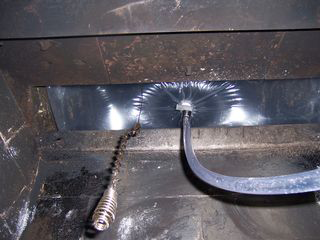
by blogediter | Sep 5, 2018 | Chimney Problems
Cable Coming Down the Flue
Q: Jason, I have a 113-year-old house with 6 fireplaces … they were originally coal-burning units .. they all have the damper on the top of the chimney … will the Chimney Ballon work with that configuration? -GB
A: Dear GB, WOW 6 fireplaces! that has to be some kind of record! It is very wise that you have a chimney top damper on these chimneys, however, the chimney top damper still allows the warm air of your home to rise up into the chimney and cool in the chimney and sink back down. You may notice a slow cool release of air from your fireplaces. That cool air is likely not outside air but just cooled inside air sinking back down again.
I have had customers with chimney top dampers that have used the Chimney Balloon on the bottom of their chimney in addition to their top damper and it has made a difference. With 6 chimneys the difference would be significant.
Q: Jason, thanks for the response … one of my concerns is if the damper cable will interfere with the Chimney Balloon sealing properly.
A: Recently a homeowner in Detroit asked me the same question you are asking when he ordered 3 Chimney Balloons for his home. He had Lock-top dampers just like you, on all three chimneys as well. After he installed the Chimney Balloon he reported that it sealed just fine despite the cable & chain. The balloon simply presses the chain against the flue wall or expands around it causing no leak or draft. You can install the Chimney Balloon with the cable tight or relaxed. The image above is a picture of the Chimney Balloon installed with the damper cable relaxed. But here is an article with a picture of a Chimney Balloon with the cable tight: http://www.chimneyballoonusa.com/blog/2007/11/my-lock-top-or-.html
– Jason
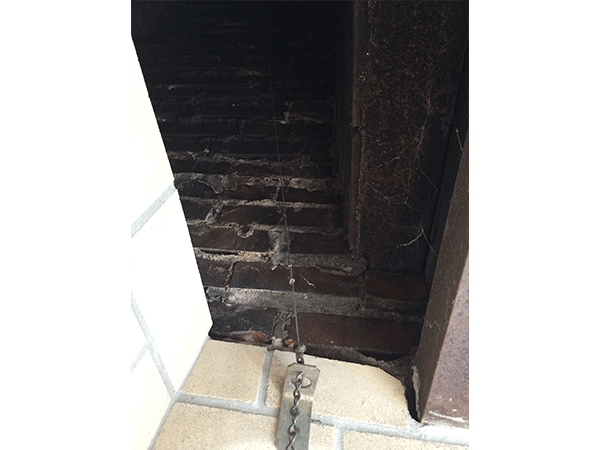
by blogediter | Aug 31, 2017 | Fireplaces
#50: I Have a Chimney Top Damper with a Cable Coming Down. How do I Plug the Flue?
50-1 Chimney Top Damper Cable Coming Thru Old Damper Frame
50-2 Chimney Top Damper Cable Entering the Firebox
50-3 Lymance Brand Top Seal Damper on Chimney Top
50-4 Damper Cable Decending Flue Tile and Smoke Shelf
50-6 Damper Cable Descending into Firebox
Fireplace #50: Chimney Top Damper with Cable Down the Flue
These retrofitted chimney top dampers come in a variety of styles and brands. They are currently a very popular solution for replacing traditional throat dampers. These are their characteristics of top-sealing dampers:
- They have a long cable or chain that descends from the damper apparatus at the chimney crown (image 50-3) to the firebox (image 50-6).
- The chimney cable locks into a bracket mounted on the side of the firebox. (image 50-6)
- If there was a lower traditional throat damper in this fireplace, it was removed or cut out to allow the cable to come down (image 50-1).
- These top-sealing dampers can be used in round flue liners, or in square flue tile (image 50-4)
The nice thing about these chimney top dampers is they are easy to open and close, and they are suitable replacements for aged and rotted throat dampers that are hard to get parts for or rebuild. The downside to these top-dampers is they tend to trap in chimney odor and can sometimes feel drafty even when they seal tightly. Bottling a chimney at the top is problematic in many ways.
The Flueblocker is the durable solution
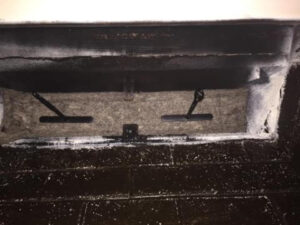 For this application, go with a Flueblocker. Here is a video on how the Flueblocker works.
For this application, go with a Flueblocker. Here is a video on how the Flueblocker works.
- Take a quick measurement of the narrow opening just above your firebox (Image 50-1). Often this will be the old metal damper frame of an old throat damper
- Buy a Flueblocker that a little large than the hole. It pressure fits, so it doesn’t hurt to have a little extra material. Just don’t buy one that is too small.
- The Flueblocker is a wool pad with extra hems, so you can trim it to size with sharp scissors.
- You can cut a small slit in the edge of the wool pad for the top-damper cable to come down through. That way you can keep the top damper closed ,and have the Flueblocker installed.





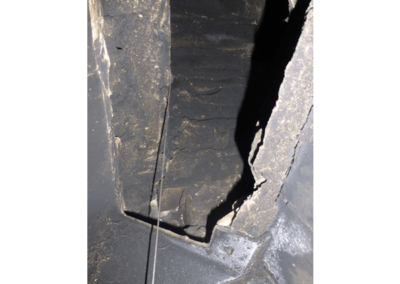
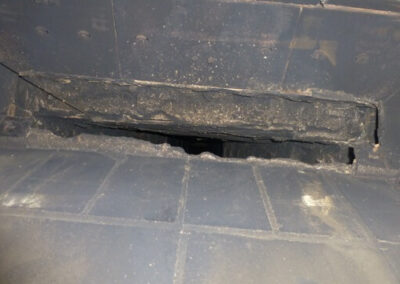
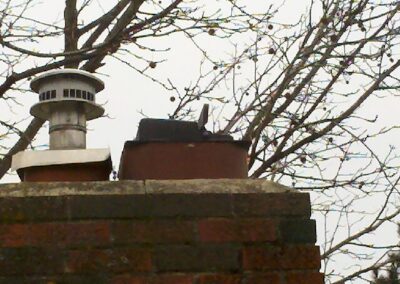
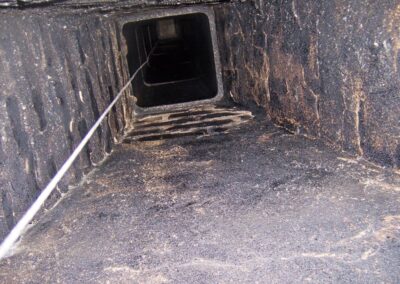
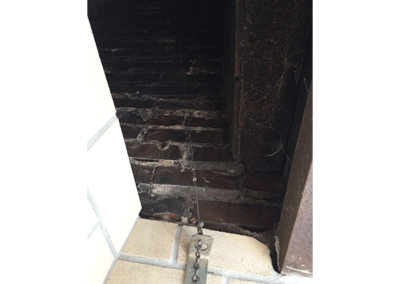
 For this application, go with a Flueblocker.
For this application, go with a Flueblocker.